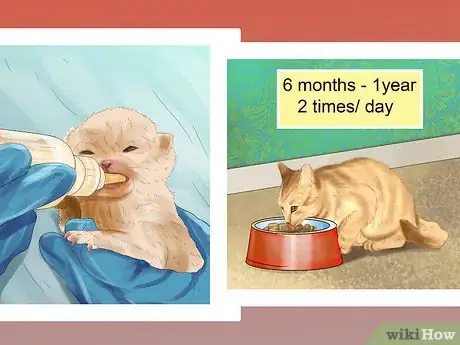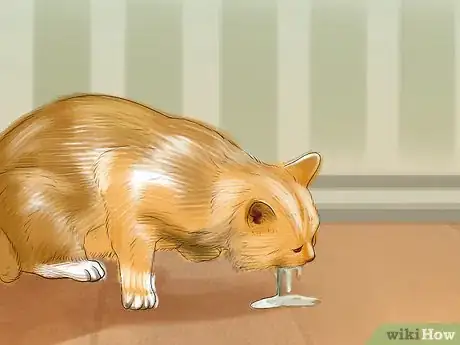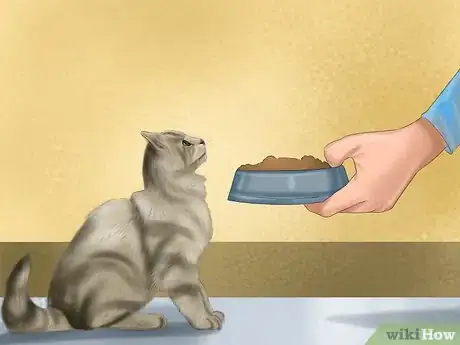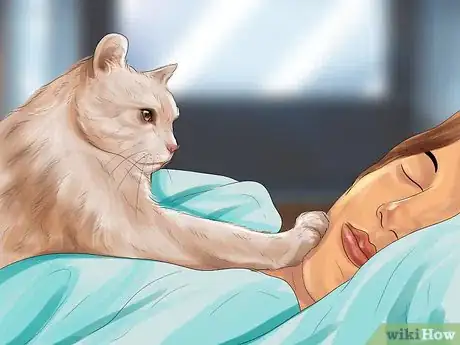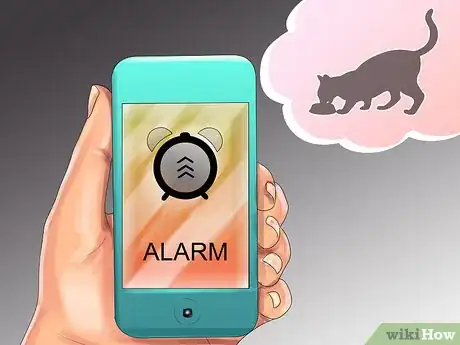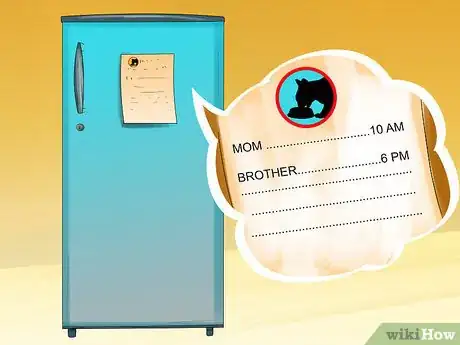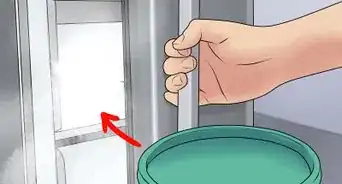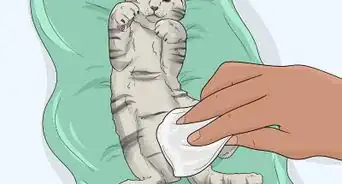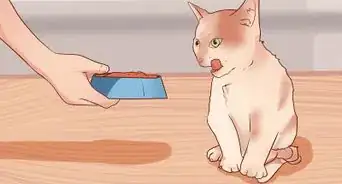This article was co-authored by Melissa Nelson, DVM, PhD. Dr. Nelson is a Veterinarian who specializes in Companion and Large Animal Medicine in Minnesota, where she has over 18 years of experience as a veterinarian in a rural clinic. She received her Doctor of Veterinary Medicine from the University of Minnesota in 1998.
This article has been viewed 30,162 times.
Coming up with (and sticking to) a feeding schedule for your cat can help ensure it is happy and healthy. Sticking to a feeding schedule helps with digestion and can ensure your cat is eating the right amount of food to keep it at a healthy weight. When you’re figuring out a feeding schedule for your cat, you should think about its age, health, and personal preferences, as well as your own schedule.
Steps
Determining How Often to Feed Your Cat
-
1Consider your cat’s age. How often you feed your cat depends, in part, on its age. Kittens need to be fed more frequently than adult cats, for example, because they are growing and expending a lot of energy. Use the following guidelines to determine how many times a day to feed your cat:
- Kittens up to six months of age should be fed three times a day.
- From six months old to about one year old, you should feed your cat twice a day.
- Adult cats (one year or older) and senior cats can be fed either once or twice a day. Feeding your cat once a day is fine as long as it is healthy and doesn’t have any diseases that require a different feeding schedule.
-
2Consider your cat’s health. Some cats may develop health problems that require you feed them at certain times during the day. For example, if your cat has diabetes, you may need to feed it when you give it medication. For these situations, it is best to consult with your veterinarian on how often you should feed your cat.
- If your cat does have a disease, treat the disease first before changing its feeding schedule. If the disease is treatable, you should be able to return to a normal feeding schedule once your cat is healthy.
Advertisement -
3Adjust meals if your cat is throwing up. Regurgitating before or after a meal can be a sign that your cat is either getting too hungry in between meals or is eating too much at once. If you notice these symptoms in your cat, try feeding it small meals more often throughout the day—possibly up to four times a day. Doing so will help keep your cat fuller throughout the day and allow it to eat smaller meals more frequently, both of which should help diffuse its need to regurgitate.
- A "slow feeder" or timed feeder that emits food in small increments will also help cats that eat too rapidly.
- It is recommended that cats eat between 24 to 35 calories per day per pound (roughly 13 calories per kilogram), so split this amount up between the total number of feedings to make sure you’re not overfeeding your cat.[1]
- If you change your cat’s feeding schedule, but it is still regurgitating consistently, take your cat to the vet to get checked out.
-
4Watch for signs your cat is overweight or underweight. You can consult with your veterinarian if you’re not sure whether or not your cat’s weight is ideal, or use a visual "body scoring system" for cats:
- Body score 1/5 (very underweight): cannot feel any fat, can see and feel hip bones and lower vertebrae, ribs visible for short-haired cats
- 2/5 (underweight): can easily feel ribs with minimal fat covering, visible lower vertebrae, visible waist behind ribs
- 3/5 (normal): can feel ribs with slight fat covering, waist visible behind ribs
- 4/5 (overweight): ribs difficult to feel due to fat, obviously rounded abdomen affecting waist shape
- 5/5 (very overweight): cannot feel ribs, no narrowing waist behind ribs, heavy fat deposits on lower back, face, and limbs.
- Talk to your vet about dietary changes before trying anything extreme. A rapid weight loss diet can cause fatty liver disease in cats.
Determining When to Feed Your Cat
-
1Pick a time that is convenient for you and your family. If you are consistent, it generally doesn’t matter what time of day you feed your cat. If your mornings are hectic trying to get ready for work and get the kids ready for school, it may be better to feed your cat in the afternoon or evening. If you’re feeding your cat two or three times a day, pick the times that are easiest for you and do your best to stick to this schedule.
- It might help you remember to feed your cat at the same time every day if you stick to a ritual. For example, put food out when you are waiting for your coffee to brew every morning, or feed your cat as soon as you get home from work in the evening.
-
2Accept that your cat will “remind” you if you don’t feed it on time. Remember, your cat will get used to the schedule you choose and may “remind” you when it’s meal time. For example, if you feed your cat around 7a.m. every Monday through Friday morning, don’t be surprised if your cat wakes you up on the weekends at this time as well. Your cat will become accustomed to the feeding schedule you set and will expect to be fed promptly.
-
3Pay attention to your cat’s preferences. Each cat is different, so your cat might prefer to be fed at a different time than your friend’s cat. For example, if you notice your cat doesn’t eat its morning meal, but seems to beg for more food before bedtime, try switching up your cat’s feeding schedule to accommodate its preferences.
- However, if your cat’s preferences make it difficult for you to maintain a consistent feeding schedule, it might be better to stick to the schedule that works best for you.
Remembering to Feed Your Cat
-
1Set a reminder on your phone. If you have trouble remembering to feed your cat at the same time each day, try setting a reminder on your phone. Although you may not always be able to feed your cat at the exact same time every day, setting daily reminders can help you remain consistent when you can.
-
2Create a schedule for your family. If your entire family takes responsibility for feeding your cat, it may be helpful to create a schedule that details who is responsible for feeding the cat, what time they should feed it, and how much they should feed it. This will help ensure your cat isn’t being double-fed or that its meals aren’t accidentally getting skipped.
- Hang the schedule somewhere everyone in the family will see it—maybe on the refrigerator door or next to your cat’s food bowls.
- It might also be helpful to have each member of the family put an “X” or slash on the schedule after they feed the cat to ensure the schedule is being followed properly.
-
3Use a timed feeder. If you are not home consistently or at the same times throughout the day, you can use a timed cat feeder to make sure your cat is getting its meals on a schedule. These feeders will work with either dry, canned, or raw foods. Using a timed feeder can be a big help in keeping your cat on a consistent feeding schedule when you are away for extended or inconsistent periods of time.
Warnings
- Over-feeding your cat can be harmful to its health, so make sure you’re feeding your cat the right amount of food throughout the day. Its total daily allowance of food should be split between all the meals it is fed.⧼thumbs_response⧽
About This Article
To design a feeding schedule for your cat, first determine how much and how often it needs to eat, depending on its age and health. For example, kittens up to 6 months of age should be fed 3 times a day, while adult cats can be fed either once or twice a day. However, if your cat is throwing up often, this could be a sign it’s getting too hungry in between meals or is eating too much at once. If so, try feeding it small meals more often throughout the day. Once you decide how often to feed your cat, make sure you are able to feed it at the same times each day. If you have trouble remembering, try setting a reminder on your phone. For more tips from our Veterinary co-author, like how to use a timed cat feeder, keep reading!
